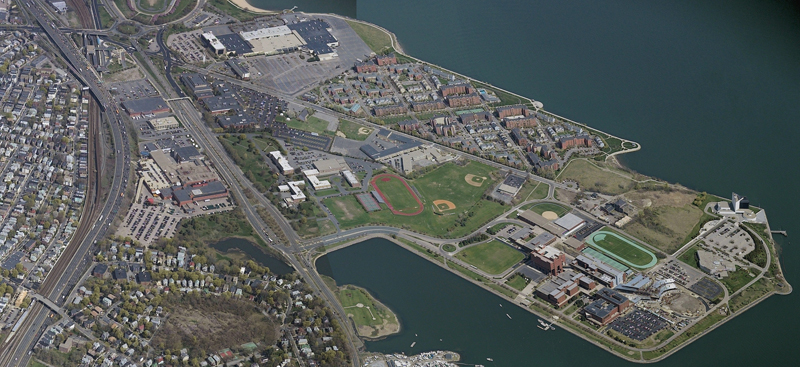
Before 1879, the Boston peninsula today known as Columbia Point, consisted of fourteen acres of marshy land. During the 19th century Dorchester residents used this land for grazing cattle, and was thus known by residents as simply the “Calf Pasture.” The Puritans first landed nearby at the place known as Mattaponnock, today’s Savin Hill.
In the 1879s, city leaders and commissioners chose the Calf Pasture for the site of the pumping station that was vital to the new sewerage system. Why here? The peninsula was distant from the more heavily populated areas of Boston, and the city could acquire it at a low cost. It was also close to the water and Moon Island, south of the city in Quincy, where the sewage would be released.
In 1879, the city initiated several land making projects on the peninsula, to prepare the area for the construction of the new sewage pumping station that would be the centerpiece of Boston’s Main Drainage Works sewerage system. The system was completed in 1884, when the Calf Pasture Pumping Station began working continuously to remove waste away from Boston.
In 1884, the Main Drainage Pumping Station and its several outbuildings were the only structures on the peninsula. The castle-like structure of the Pumping Station stood out on the marshy lands of Calf Pasture; it was accessible only by “Mile Road,” today known as Mount Vernon Street. During the 1880s, landmaking accommodated the construction of several Bay State Gas Company gas tanks just south of the Calf Pasture.
In the 20th century, more land resulted from filling in the flats at the end of the Calf Pasture and along the coast between Calf Pasture and Savin Hill for the construction of “Old Colony Boulevard,” now William T. Morrissey Boulevard, which opened to automobile traffic in 1928.
In 1942, a military camp was built on the peninsula. During the Second World War, Camp McKay housed Italian prisoners of war. After the war, the camp’s barracks were repurposed as public housing, known as the “Columbia Village housing project”.
Boston College High School relocated from the South End to Dorchester in 1950. In 1958, the Boston Globe relocated its operations to Morrissey Boulevard, just across the street from the Boston College High School, at the edge of Columbia Point. The barracks-turned-public housing were demolished soon after to make way for a shopping center and the Calf Pasture thus became known as Columbia Point.![]()
The peninsula saw even further changes in the last quarter of the 20th century. In 1974, the pumping station (by then unused), had another new neighbor when University of Massachusetts Boston officially opened its doors to students on their new campus at Columbia Point. The John F. Kennedy Presidential Library and Museum was established in 1979, and the Massachusetts State Archives opened in 1985. In the late 1980s, developers transformed the Columbia Point housing project into the Harbor Point community. By 1990, Calf Pasture was a vastly different place than when the pumping station was built. Certainly entirely different from when the Puritans first landed nearby the place known as Mattaponnock, the peninsula’s modern day neighbor, Savin Hill.
Sources:
- Clark, Eliot C. Main Drainage Works of the City of Boston. Boston: Rockwell and Churchill, 1885.
- Roessner, Jane. A Decent Place to Live: From Columbia Point to Harbor Point: A Community History. Boston: Northeastern UP, 2000.
- Taylor, Earl. “Calf Pasture Pumping Station.” Dorchester Atheneum. Dorchester Historical Society, 30 May 2005. Web. 06 March 2013.
- “Urban Transformations: Columbia Point – Harbor Point Boston.” <http://004e136.netsolhost.com/images/7HP.pdf>.
Photo Credits:
- Boston Redevelopment Authority; www.bostonredevelopmentauthority.org
- Map hosted by Google Maps. Please click on the image to be directed to the map.
